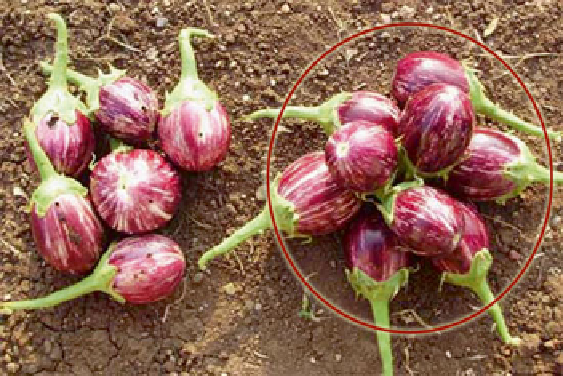Agriculture Reference
In-Depth Information
• Costa Rica now has resistant Atzimba.
• For both North Africa (Egypt, Tunisia,
Morocco) and the Southern cone of South
America (Argentina, Chile), Desiree has been
transformed with the Bt gene.
Desiree potato plants were genetically modifi ed
to resist attack by insect species belonging to the
orders Coleoptera (Colorado potato beetle, CPB)
and Lepidoptera (potato tuber moth (PTM) and
European corn borer (ECB)), through the insertion
of such a hybrid gene SN19 under the control of a
chrysanthemum ribulose-1, 5-bisphosphate carbox-
ylase/oxygenase small subunit (Rubisco SSU) pro-
moter and terminator (Naimov et al.
2003
).
Transgenic plants were shown to be resistant against
CPB larvae and adults, PTM larvae, and ECB lar-
vae. These are the fi rst transgenic plants resistant to
pests belonging to two different insect orders.
Bt brinjal has been developed by inserting a
gene cry1Ac from a soil bacterium,
B. thuringi-
ensis
, through an
Agrobacterium
-mediated gene
transfer. The Event EE1 was introgressed by
plant breeding into various local varieties such as
Malpur local, Manjari gota, Kudachi local, Udupi
local, 112 GO, and Pabkavi local (Fig.
7.8
).
Bt soybean (
Glycine max
) MON 87701 was
developed by
Agrobacterium
-mediated transfor-
mation of soybean using the 2 T-DNA plasmid
vector PV-GMIR9, which produces one
B.
thuringiensis
subsp.
kurstaki
protein, Cry1Ac.
This protein is intended to provide protection
from feeding damage caused by a number of lepi-
dopteron pests, such as the velvet bean caterpillar
(
Anticarsia gemmatalis
), soybean looper
(
Pseudoplusia includens
), soybean axil borer
(
Epinotia aporema
), and sunfl ower
looper
(
Rachiplusia nu
) (Fig.
7.9
).
Many rice varieties have been transformed
with genes encoding various Bt crystal (Cry)
proteins and have been shown to be resistant to
one or more lepidopteron pests of rice, the
most important of which are the yellow stem
borer (
Scirpophaga incertulas
), the striped
stem borer (
Chilo suppressalis
), and several
species of leaf folders (
Marasmia
spp. and
Cnaphalocrocis medinalis
) (Pathak and Khan
1994
) (Fig.
7.10
).
Commercially available genetically modifi ed
crops resistant to infect pests are presented in
Table
7.9
(Castle et al.
2006
).
7.20.7 Integrated Pest Management
Integrated pest management (IPM) is an effective
and environmentally sensitive approach to pest
management that uses current, comprehensive
information on the life cycles of pests and their
interaction with the environment to manage pest
damage by the most economical means and with
the least possible hazard to people, property, and
the environment.
Fig. 7.8
Damage caused
by brinjal fruit and shoot
borer (
left
) and Bt brinjal
developed by MAHYCO
(
right
)

Search WWH ::

Custom Search